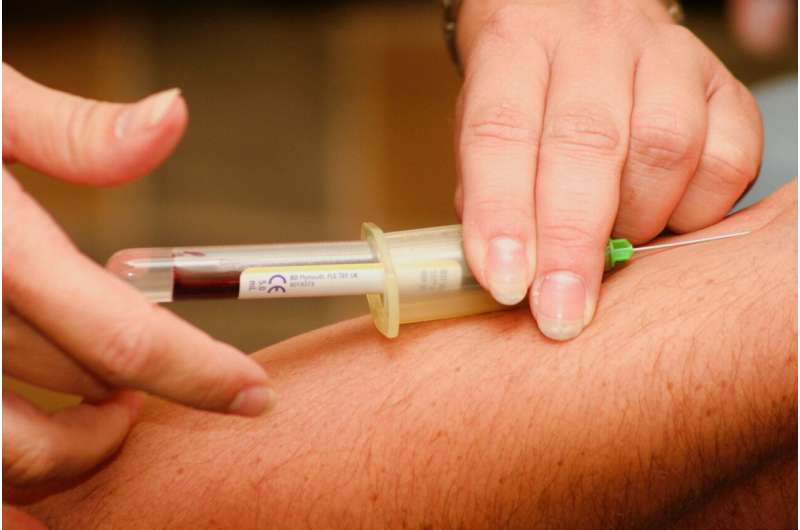This article has been reviewed according to Science X's editorial process and policies. Editors have highlighted the following attributes while ensuring the content's credibility:
fact-checked
proofread
Scientists have a new tool in the race to improve the diagnosis and prognosis of sepsis

Researchers from Lund University in Sweden have identified distinct molecular signatures associated with the clinical signs of sepsis that could provide more accurate diagnosis and prognosis of sepsis, as well as help to target specific therapies at patients who would benefit most, according to new research being presented at this year's European Congress of Clinical Microbiology and Infectious Diseases (ECCMID 2024) in Barcelona, Spain (27-30 April).
"A simple blood test when combined with a personalized risk model has the potential to save lives by providing more accurate sepsis diagnosis and determining who may go on to develop more severe clinical manifestations," says co-lead author Dr. Lisa Mellhammar from Lund University, Sweden.
"It's vital that patients with suspected sepsis are identified prior to the onset of organ failure. Given the challenges associated with timely diagnosis and the fact that sepsis kills millions of people around the world every year, there is an urgent demand for an alternative approach."
Sepsis is a life-threatening organ-dysfunction triggered by a severe infection. Severe sepsis and septic shock are progressive stages of sepsis, associated with multi-organ failure and death.
According to WHO, there were an estimated 49 million sepsis cases and 11 million potentially preventable deaths in 2017—accounting for almost 20% of all global deaths.
One of the persistent challenges in treating sepsis is the lack of timely diagnosis, as there is no singular diagnostic test that reliably detects sepsis. Current practices rely on broad-ranged biomarkers such as CRP (C-reactive protein, an inflammation marker), PCT (procalcitonin, a pro-hormone), and lactate for the detection of sepsis.
Additionally, sepsis is a highly variable disease that can arise from a multitude of causes, and despite hundreds of clinical trials there are no targeted treatments, and clinicians currently rely on the broad-spectrum use of antibiotic, antiviral, and antifungal therapies.
"It's difficult to predict who will get sepsis, who will recover, and who will have poor outcomes," says co-lead author Dr. Adam Linder from Lund University, Sweden.
"We urgently need better ways to understand sepsis at the molecular level so we can classify suspected sepsis patients according to the clinical manifestations of their illness and identify high-risk patients and develop more effective treatments."
In this study, researchers set out to investigate the distinct proteomic signatures (unique patterns of proteins that are associated with immune response in patients with sepsis) associated with different clinical symptoms and outcomes, such as different organ dysfunctions and infections.
They included 1,364 plasma samples from randomly selected adult patients with suspected sepsis admitted to the emergency department at Skåne University Hospital between 1 September 2016 and 31 March 2023. Overall, 1,073 out of 1,364 patients had an infection, and of these 913 had sepsis.
The researchers used mass spectrometry to analyze the plasma samples and generate comprehensive molecular maps to better understand patterns of proteins that were predictive of septic shock. Each protein panel was then combined into a molecular signature to train a machine-learning model, allowing researchers to predict which patients would develop septic shock with high accuracy.
Patients were then classified into low, medium, or high probability of developing septic shock and the model was able to show how increasing risk was associated with higher mortality.
The researchers also identified panels of proteins that were predictive of six different types of organ dysfunction (cardio, central nervous system, coagulation, liver, kidney, and respiratory) and infection. They analyzed the biological processes associated with each panel to show how their unique proteome signatures influence sepsis.
Patients were then classified into five risk categories based on the probabilities of having organ dysfunctions and infection and the risk of dying.
"A fast test that provides more accurate sepsis diagnosis and could also predict who is at greater risk of poorer outcomes now seems a genuine possibility," says Mellhammar.
"Any research like this needs clinical validation and many hurdles must be cleared before these biomarkers are used in the clinic. But we envision this as a tool that could be deployed worldwide, as the future of early detection of sepsis."
Despite the promising findings, the authors outline some limitations of their study, including that because sepsis is a highly variable disease, it is important that the findings are validated in different cohorts and settings.
Additionally, because sepsis is a dynamic syndrome that progresses during the disease, repeated samples need to be taken from sepsis patients to study how the progress from earlier to later states affects the proteome. The authors also note that these data could benefit from further analysis, using for example, transcriptomics.

















